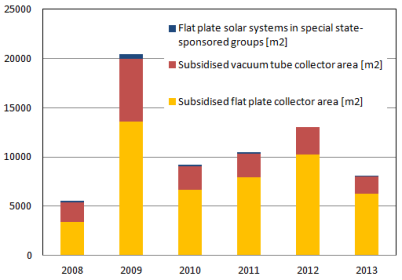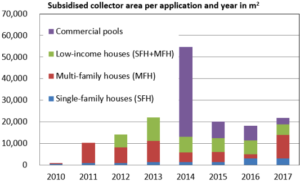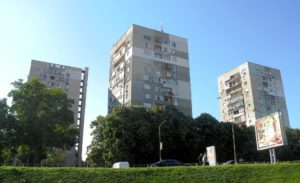Slovenia: Grant and Loan Scheme in Its Sixth Year
March 30, 2014
At the end of February, the Slovenian subsidy scheme restarted with a new call for applications. Eco Sklad, the Slovenian Environmental Public Fund, has been promoting renewable energies through non-repayable subsidies (grants) and low-interest (soft) loans since 2008. Each year, the scheme supports solar thermal systems, as well as wood boilers and efficiency measures in passive houses until its annual budget runs out. This budget was spent fairly quickly last year. “The budget of EUR 20 million had already been spent in August 2013 and no more applications were possible,” Anton Jančič, Director of Slovenian collector manufacturer Lentherminvest, says. “It is hard to cope with the interruption of 6 months, because demand drops to almost zero when there are no subsidies available.” The chart shows the collector area subsidised each year. In total, Eco Sklad supported the installation of 66,896 m² of collector area over the last six years.
Source: Eco Fund

This year, Eco Sklad has a grant budget of EUR 21.5 million available. Provided that the number of applications remains at the level of last year, the scheme will again come to a premature halt. The fund budget is divided in two parts: EUR 15 million have been allocated for single-family and semi-detached houses and EUR 6 million for renewables in multi-family buildings. A special public subsidy scheme for electric cars has a budget of EUR 0.5 million. The money for the grant scheme is collected through levies on end consumer energy bills – specified in EUR-cent per unit and type of consumed energy (see the database of incentive programmes for more information).
Larger subsidies for vacuum tube collectors
According to the chart above, the number of solar thermal applications was a lot lower in 2013 than in previous years. Eco Sklad has not yet analysed why there was such a strong decline, Tadeja Kovačič, Eco Fund Advisor, confirms. “It may be that we have reached the point where the market is saturated, or it may be that some houses do not have very good locations, positions, roof orientations, etc for the collectors and require additional infrastructure to allow the installation of the solar systems, which would lead to additional costs,” Kovačič offers possible explanations for the decline.
“We have not changed the requirements of the grant scheme this year,” the adviser confirms. The fund subsidises flat plate collectors with 150 EUR/m² and vacuum tube collector systems with 200 EUR/m². “We do not agree with the larger subsidy for vacuum tube collectors, but our protests did not help,” Jančič, whose company Lentherminvest is the only flat plate collector manufacturer in Slovenia, explains. Grants for both technologies are capped at a maximum of 20 m² per residential unit. “This does not mean that there are no bigger systems allowed,” Kovačič says. If a house owner aims at installing 25 m² of flat plate collectors, he will receive a maximum of 20 times 150 EUR/m², which translates into 3,000 EUR.
More information:


